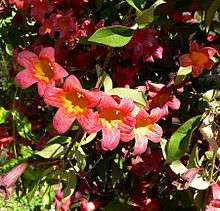Bignonia capreolata
Bignonia capreolata is a vine commonly referred to as crossvine.[2] The common name refers to the cross-shaped pattern revealed when the stem is cut; this pattern results from four radial wedges of phloem embedded within the stem’s xylem.[3] It is native to the central and southern United States.[4] The vine climbs without twining but does produce tendrils. It produces long tubular flowers which are red and yellow and frequently have a mocha fragrance.[5] The leaves are dark green to almost purple and produced as opposite pairs with terminal tendrils. The vine often climbs very high, with leaves only remaining on the uppermost portion of the plant. Crossvine can spread aggressively through stolons and become invasive unless properly managed.[6]
| Bignonia capreolata | |
|---|---|
 | |
| Scientific classification | |
| Kingdom: | Plantae |
| Clade: | Tracheophytes |
| Clade: | Angiosperms |
| Clade: | Eudicots |
| Clade: | Asterids |
| Order: | Lamiales |
| Family: | Bignoniaceae |
| Genus: | Bignonia |
| Species: | B. capreolata |
| Binomial name | |
| Bignonia capreolata | |
| Synonyms[1] | |
| |
There was for some time confusion surrounding the name of this plant, which was apparently sometimes referred to as "Bignonia crucigera", a name more properly referring to a different plant altogether.[7]
Medicinal use

One 18th century report describes a medicinal use for cross-vine by the Cherokee people:
"The vines or climbing stems of the climber (Bigonia Crucigera) are equally divided longitudinally into four parts by the same number of their membranes somewhat resembling a piece of white tape by which means, when the vine is cut through and divided traversely, it presents to view the likeness of a cross. This membrane is of a sweet, pleasant taste. The country people of Carolina crop these vines to pieces, together with china brier and sassafras roots, and boil them in their beer in the spring, for diet drink, in order to attenuate and purify the blood and juices. It is a principal ingredient in Howard's famous infusion for curing the yaws, etc., the virtues and use of which he obtained from Indian Doctors."[8]
In 2012, researchers at Bastyr University published a paper revealing that they had identified the indole alkaloid reserpine in Crossvine.[9]
References
- The Plant List: A Working List of All Plant Species, retrieved 16 November 2016
- Dirr, Michael. 1997. Dirr's Hardy trees and shrubs: an illustrated encyclopedia. Timber Press. 493 pages.
- Metcalfe, C.R. and L. Chalk. 1950. Anatomy of the dicotyledons. Volume II. Oxford: Clarendon Press. (see page 1009).
- USDA plant profile
- Ask Melinda: Crossvine
- USDA NRCS. Plant Guide. Crossvine: Bignonia capreolata L.
- Alwyn H. Gentry, Bignonia crucigera: A Case of Mistaken Identity, Taxon 24(1): 121-123 (Feb. 1975), a relevant portion of which may be previewed here.
- William Bartram, Observations on the Creek and Cherokee Indians food traditions, in Transactions of the American Ethnological Society Vol. 3 Pt. 1. Extracts (1789).
- Clark, T. and K.C. Lund. "Presence of the Indole Alkaloid Reserpine in Bignonia Capreolata L." International Journal of Pharmacognosy and Phytochemical Research. September–November 2012. Archived 2016-03-04 at the Wayback Machine
External links
- Bioimages from Vanderbilt University
- Trees, Shrubs, and Woody Vines of North Carolina: Crossvine (Bignonia capreolata)
- USDA Natural Resources Conservation Service. Crossvine (Bignonia capreolata)
| Wikimedia Commons has media related to Bignonia capreolata. |